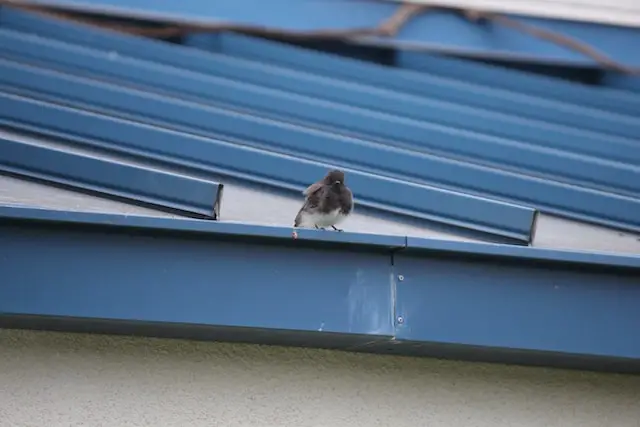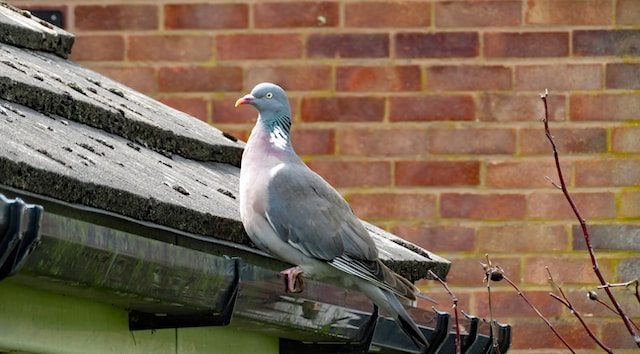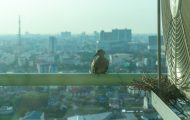When we think of the enchanting world of birds, our minds often conjure images of them soaring through the sky or perched among the branches of towering trees. However, nature has a tendency to surprise us with its adaptability and creativity. One such fascinating phenomenon is the unexpected choice of some birds to nest in guttering—those unassuming channels designed to manage rainwater in our homes. In this article, we’ll delve into the curious world of birds nesting in guttering, exploring why they choose such unconventional locations and the intriguing implications for both the birds and our urban environments.
The Attraction of Guttering as Nesting Sites
Guttering, the system of channels installed along the edges of roofs to collect and redirect rainwater, can sometimes become attractive nesting sites for certain animals, particularly birds. While guttering is not a natural nesting environment, it can offer some advantages for nesting animals, which might explain their attraction to these locations:
🟦 Elevated Position
Birds are instinctively drawn to elevated locations for nesting, as they offer a vantage point that reduces the risk of ground-based predators reaching their nests. Guttering, situated along the roof’s edges, provides a natural advantage for safety. This height advantage allows birds to keep a watchful eye on their surroundings, enhancing their ability to protect their nests and young from potential threats.
🟦 Shelter and Cover
Imagine being a bird in need of a safe haven for your family. Guttering comes to the rescue with its ingenious design – a snug channel that provides not just shelter but also a protective cover. It shields nesting birds from the capricious elements, such as rain showers and gusty winds, ensuring their precious eggs or hatchlings are shielded from harm’s way.
🟦 Nesting Material Availability
Nature has a knack for providing resources where they’re needed most. For birds looking to construct cozy nests, guttering is like a treasure trove of materials. Over time, leaves, twigs, and other organic debris gather within these channels, forming a veritable DIY bird’s nest workshop. Birds can pluck these materials with ease, saving them energy and time in the nest-building process.
🟦 Proximity to Food Sources
The allure of guttering for birds is not limited to just a snug abode. It’s also a culinary hotspot! The accumulation of moisture and organic matter within guttering creates an enticing environment for insects and small invertebrates. As if having a comfy home wasn’t enough, guttering provides a convenient buffet of delectable treats right at the doorstep, ensuring parent birds can easily find sustenance for themselves and their hungry chicks.
🟦 Less Human Disturbance
Imagine the tranquility of a secluded vacation spot, far from the hustle and bustle of tourist crowds. Guttering offers a similar refuge for birds seeking a nesting site. Typically located in quieter, less frequented corners of homes, guttering provides an environment where avian families can raise their young without the constant disruptions that might come with bustling human activity.
🟦 Structural Stability
When it comes to architecture, nature is the ultimate engineer. Guttering’s architecture inadvertently caters to nesting birds by providing a sturdy foundation. The snug enclosure of the gutter channels ensures that once a nest is constructed, it’s less likely to fall apart due to sudden gusts of wind or other environmental disturbances.
🟦 Camouflage
In the realm of survival, staying hidden from potential threats is a top priority. Guttering, with its array of designs and colors, doubles as a built-in camouflage for nests. Birds can expertly blend their nests into the gutter’s surroundings, minimizing the risk of predators spotting them and allowing parents to tend to their offspring without constant fear of attacks.
🟦 Adaptability
Birds are nature’s original adaptors, thriving in diverse environments. Guttering, despite its engineered purpose, becomes a canvas for avian creativity. If a bird species discovers that guttering provides the right combination of safety, resources, and suitability for nesting, it’s more than happy to capitalize on this newfound nesting oasis.
These are the multifaceted reasons why guttering, designed for rainwater management, inadvertently becomes a sanctuary for birds seeking a secure, resource-rich, and strategically located place to establish their nests and nurture their next generation.
Bird Species that Nest in Guttering
Some bird species are known to nest in guttering or similar structures around buildings. However, it’s important to note that birds nesting in guttering can potentially cause damage to the gutter system, create blockages, and lead to other issues. If you’re experiencing this problem, you might want to consider taking measures to discourage nesting in these areas.
A few bird species that might nest in guttering include:
🟩 House Sparrow
The House Sparrow, a small and adaptable bird, is notorious for finding shelter in human structures, including guttering and eaves. These sociable birds construct their nests with a haphazard charm, combining twigs, grass, feathers, and any other odds and ends they come across. Their nests can be a bit untidy, but they reflect the resourcefulness of these urban dwellers.
🟩 European Starling
The European Starling, with its glossy black plumage speckled with iridescent spots, is a common sight in urban areas. Drawn to the crevices of buildings, including guttering, starlings craft nests from an eclectic mix of materials. Their artistic prowess is evident as they interweave grass, twigs, and feathers to create cozy abodes that often hang suspended from their chosen nesting sites.
🟩 Pigeons
Pigeons, often regarded as city denizens, are no strangers to nesting in various nooks and crannies. With a gentle cooing that’s familiar to urban dwellers, these birds may opt for guttering as nesting spots. Their nests, while not as elaborate as some, are utilitarian, constructed from twigs and other available materials, and provide a snug haven for raising their young.
🟩 House Finch
Distinguished by their vibrant plumage, House Finches usually prefer natural settings for nesting, but their adaptable nature has led them to urban environments, including guttering. Delicate cup-shaped nests made of grass, string, and other fibers are tucked away in the corners, showcasing their ability to adapt their nesting style to various settings.
🟩 Barn Swallow
The Barn Swallow, with its long forked tail and gracefully curved wings, is a symbol of summer for many. These agile birds are known for their acrobatic flights and are fond of nesting in sheltered areas like barns, sheds, and eaves, which often include guttering. Their cup-shaped nests are architectural marvels, carefully crafted from mud, grass, and feathers.
🟩 Common Swift
The Common Swift, a master of the skies, is built for a life on the wing. These birds often nest in crevices and openings in buildings, and if suitable spaces are available, guttering might be included. Their nests are minimalistic, made primarily of feathers and other lightweight materials, reflecting the swifts’ swift-paced lifestyle.
🟩 Black-capped Chickadee
The Black-capped Chickadee, a cheerful and charming little bird, usually opts for natural tree cavities for nesting. However, in urban environments, they might occasionally venture into guttering or similar spots. With a fondness for cozy spots, these birds create their nests with moss, fur, and other soft materials, providing a warm haven for their young.
Remember, the avian world’s adaptability and ingenuity in utilizing diverse nesting sites remind us of the dynamic relationship between nature and urban landscapes.
Challenges and Solutions for Birds Nesting in Guttering

Birds nesting in guttering can cause various issues for homeowners. Here are some challenges posed by birds nesting in guttering and potential solutions:
🟫 Challenges
1. Blockage
The accumulation of bird nests in gutters poses a significant challenge. As nests collect in the narrow passageways of gutters, they obstruct the natural flow of rainwater. This obstruction can lead to water backing up and overflowing, potentially causing damage to the roof, fascia boards, and even the foundation of the house. Addressing this issue promptly is crucial to prevent structural damage.
2. Water Damage
Blocked gutters due to bird nests can result in water overflowing onto the roof, walls, and around the foundation. This excess water can seep into roofing materials, causing leaks that compromise the structural integrity of the roof. Additionally, the overflow can saturate walls, leading to potential interior water damage and contributing to the deterioration of the foundation over time.
3. Nesting Debris
Bird nests are typically composed of twigs, leaves, feathers, and other debris. Over time, these materials can accumulate and create additional blockages within the gutters. This can exacerbate water flow problems and make it even more challenging to maintain proper drainage. The buildup of nesting debris can turn into a persistent maintenance issue.
4. Health Concerns
Bird nests often harbor parasites, bacteria, and insects that can pose health risks to humans. These pathogens can be transmitted through feces and other biological materials present in the nests. When bird nests are in close proximity to living spaces, there’s an increased likelihood of these harmful microorganisms finding their way into the home environment, potentially causing diseases.
🟫 Solutions
1. Install Gutter Guards
Gutter guards, also known as screens or covers, are physical barriers placed over the gutters to prevent birds from accessing the interior. These guards allow rainwater to flow through while effectively blocking birds and debris from entering. Installing gutter guards minimizes the chance of nests forming and obstructing water flow.
2. Regular Maintenance
Implementing a routine maintenance schedule for gutter cleaning and inspection is essential. Regularly removing debris, leaves, and other potential nesting materials from the gutters can prevent birds from finding suitable spots for nesting. By staying proactive, homeowners can ensure that their gutters remain free of blockages.
3. Remove Existing Nests
In the event that bird nests are already present, it’s important to safely remove them. Taking care not to harm any birds in the process, gently dislodge the nests and discard them appropriately. This step prevents further accumulation and encourages birds to seek nesting sites elsewhere.
4. Use Deterrents
Employ visual and auditory deterrents around the gutter area to discourage birds from nesting. Hanging reflective objects, wind chimes, or even scarecrow-like figures can disrupt the comfort of potential nesting spots. Birds are sensitive to changes in their surroundings, and these deterrents can make the area less appealing to them.
5. Trim Trees and Shrubs
Birds often use nearby trees and shrubs as launch points to access gutters. Regularly trimming branches away from the roofline creates a physical barrier, limiting the birds’ ability to reach the gutters. This strategy reduces the likelihood of nests being built in the first place.
6. Seal Entry Points
Inspect the exterior of your home for any gaps or openings that birds might be using to access the gutters. Seal these entry points with appropriate materials to prevent birds from getting inside. However, ensure that no birds are inadvertently trapped inside the gutters during this process.
7. Provide Nesting Alternatives
Encourage birds to nest in designated areas by installing birdhouses or nesting boxes in locations away from the gutters. By offering suitable alternatives, you redirect their nesting instincts and reduce the chances of them choosing your gutters.
8. Ultrasonic Devices
Utilize ultrasonic devices designed to emit high-frequency sounds that are uncomfortable for birds but inaudible to humans. These devices create an environment that birds find unfavorable, encouraging them to seek quieter locations for nesting.
9. Professional Help
If the bird nesting issue persists, consider seeking assistance from a professional pest control service that specializes in bird management. Professionals can provide effective and ethical solutions tailored to the specific bird species and situation.
10. Legal Considerations
Before implementing any deterrents or attempting to remove nests, it’s crucial to research and adheres to local and federal laws protecting birds. Many bird species are legally protected, and violating these regulations can lead to legal consequences. It’s important to prioritize humane methods that avoid harm to birds while addressing the issue.
Creating Bird-Friendly Environments
Creating bird-friendly environments is a wonderful initiative that not only benefits our feathered friends but also contributes to a healthier and more diverse ecosystem. Here are some steps you can take to create a bird-friendly environment:
🟪 Native Plants
When planning your garden or outdoor space, prioritize native plants that are indigenous to your region. These plants have evolved alongside local bird species, providing them with the food sources they are accustomed to. Native plants offer a variety of seeds, fruits, and insects that birds rely on for sustenance. By choosing native plants, you’re essentially creating a buffet of familiar and nutritious options for the birds.
🟪 Provide Shelter
Imagine your outdoor space as a safe haven for birds. To make it inviting, incorporate a range of shelters such as bushes, shrubs, and trees. These natural hideaways offer protection from both predators and inclement weather. Different bird species have different preferences for nesting and resting, so providing a variety of shelter options creates a cozy neighborhood for various avian residents.
🟪 Water Source
Just like we humans need access to water, birds too require a reliable water source. Installing a bird bath, small pond, or even a shallow dish of water gives birds the chance to drink and bathe. Imagine the joy of watching colorful feathered visitors splashing around and taking sips on a warm day—it’s like running a welcoming spa for your avian friends.
🟪 Bird Feeders
Picture your outdoor space as a charming café for birds. By placing bird feeders strategically, you’re offering a diverse menu of bird seeds. Think of it as catering to a variety of tastes; some birds prefer sunflower seeds, while others go for suet or nyjer seeds. Keeping these feeders clean and well-stocked is akin to maintaining a popular restaurant that ensures no bird goes hungry.
🟪 Avoid Chemicals
Think of your outdoor space as an ecological haven, free from harmful chemicals. By minimizing or eliminating pesticides, herbicides, and fertilizers, you’re providing a safe environment for both birds and the insects they rely on for food. Imagine the harmony that results when you let nature’s balance flourish without human-made disruptions.
🟪 Reduce Window Collisions
Consider your windows as an obstacle course for birds. They often don’t perceive glass as a barrier and may collide with it. To prevent this, imagine adding colorful decals or patterns that make windows more visible to birds. This simple step could save many bird lives, turning your home into a bird-friendly sanctuary.
🟪 Provide Nesting Sites
Every bird deserves a cozy home, and your outdoor space can offer just that. Research the nesting preferences of local bird species. If you imagine your space as a real estate developer, strategically place nesting boxes, provide nooks in trees, or create safe corners for ground-nesting birds. Think of the satisfaction of knowing you’re helping birds build their families.
By considering these steps, you’re not only crafting a bird-friendly environment but also contributing to the health and vitality of your local ecosystem. Your efforts, much like those of a nurturing guardian, play a vital role in fostering a harmonious coexistence between humans and the vibrant world of birds.
Final Words
The world of birds never ceases to amaze us, showcasing their remarkable ability to adapt and find refuge even in the most unexpected corners of our urban landscapes. The sight of birds nesting in guttering serves as a testament to their resourcefulness and determination to thrive in a world dominated by human structures.
As we marvel at these small yet significant interactions between nature and our built environment, let’s remember to appreciate and respect the delicate balance that exists, allowing us to coexist with the wild creatures that share our world. So, the next time you notice a pair of feathered friends nesting in your guttering, take a moment to marvel at the wonders of nature’s ingenuity right at your doorstep.
To learn more about the bird nesting guide, just click here!




